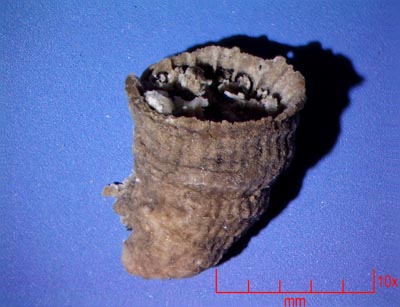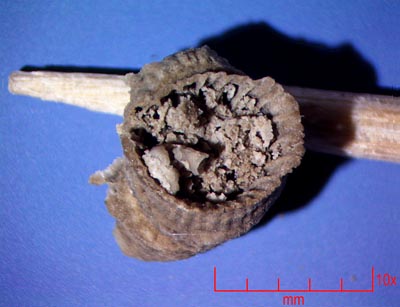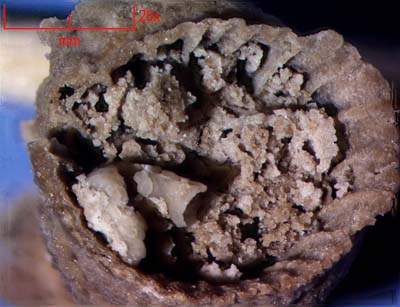|
Ten times
rarer than trilobites, rugose corals are a very small part of
the Fort Apache Sea benthic community. We only found one specimen
in over 230 pounds of limestones that went into the acid bath.
And its a small one - not even 1 centimeter in length. But its
cnidarian features are unmistakable. Winters in his monumental
monograph on the Fort Apache Fossils (GSA Memoir 89) found a
very similar coral, in fact it appears to be identical to his
photos - Lophamplexus sp. In addition to this rare coral find,
just inside the calice was a coiled microconchid tube, which
cemented itself to the coral after it had expired and was an
empty husk lying on the sea bottom.
Why corals are
so rare goes along with the missing crinoids, blastoids, sponges
and brachs. The bottom of the Fort Apache Sea was filled with
gooey muck from settled silt and sand from the nearby Schnebly
Aeolian dune field. With a constant rain of such fine material,
the filter feeding mechanisms of such animals would not function
properly and get clogged. So only silt tolerant organisms are
found here.
All images with
an AmScope Trinocular microscope, 10mp camera and stacked with
focus stacking software - Picolay. (free!)

|
Lophamplexus
sp. - 7x. Side view showing detail in the crenelations and bands
on the exterior. |
 |
Lophamplexus
sp. with the microconchid tube on the left edge inside. 7x. You
can see the septa defining the corals calice as ridges on the
inside wall. |
 |
Lophamplexus
sp. This Close up at 20x shows the interior is filled with essentially
sand that has been cemented together along with the coiled microconchid
with its open tube on the lower left inside. The tube worm lived
by cementing itself to a flat hard surface for an anchor. We
have found plenty of them attached to urchin spines, shells and
bryozoans. (Think similar to modern feather duster marine worms). |
|
